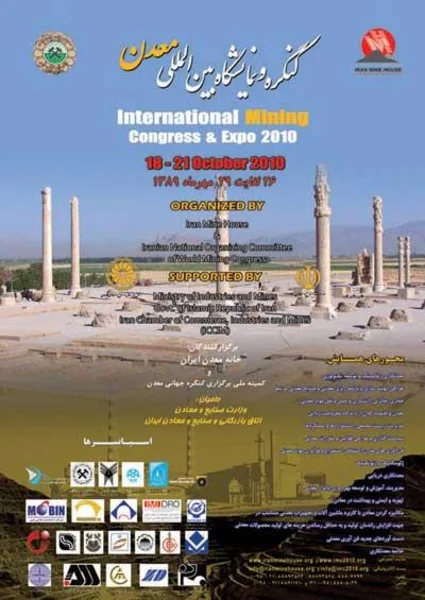-
gold-copperporphyry and low-sulfidation goldbearing system of bolnisi mining district
جزئیات بیشتر مقاله- تاریخ ارائه: 1389/07/20
- تاریخ انتشار در تی پی بین: 1389/07/20
- تعداد بازدید: 511
- تعداد پرسش و پاسخ ها: 0
- شماره تماس دبیرخانه رویداد: -
the system is included in the tethyan-eurasian metallogenic belt. the belt spreads from the lesser caucasus to turkish pontides, via black sea continues to bulgarian srednegorie, till banat and carpathian apuseni and consists of well known copper-porphyry deposits murgul, cheratepe, chelopech, medet, elshitsa, bor, maidapek and baye mare. bolnisi mining district consists of two clusters separated by regional fault. the deposits are composed by two zones of mineralization. the high sulphidation zone represent goldcopperporphyry and goldbearing polymetallic mineralization, it is overlain by low sulfidation goldbearing mineralization in quartz-chalcedony and quartz-barite veins and stockworks. the generation of late cretaceous volcanics and mineralization is related to island-arc volcanic activity above the subductive slab in the late subduction and syncollision situation. the hinge retreat and slab detachment caused enrichment of the late cretaceous magma with depleted mantle material and appearance the org and wpg trends in volcanics. the slab retreat was the reason the transtensional block faulting and subsidence, and thus to preservation of near surface magmatic hydrothermal products. so, submerged nw block contained younger cluster of mineralization (80-81ma), whereas uplifted se block – older cluster (88-89 ma). the younger cluster of mineralization in the se block must be eroded.
مقالات جدیدترین رویدادها
-
استفاده از تحلیل اهمیت-عملکرد در ارائه الگوی مدیریت خلاقیت سازمانی و ارائه راهکار جهت بهبود
-
بررسی تاثیر ارزش وجوه نقد مازاد بر ساختار سرمایه شرکت های پذیرفته شده در بورس اوراق بهادار تهران
-
بررسی تأثیر سطح افشای ریسک بر قرارداد بدهی شرکت های پذیرفته شده در بورس اوراق بهادار تهران
-
بررسی تأثیر رتبه بندی اعتباری مبتنی بر مدل امتیاز بازار نوظهور بر نقد شوندگی سهام با تأکید بر خصوصی سازی شرکت ها
-
تأثیر آمیخته بازاریابی پوشاک ایرانی بر تصویر ذهنی مشتری پوشاک ایرانی (هاکوپیان)
-
جداسازی اکسید روی از لجن واحد آگلومراسیون ذوب آهن اصفهان به روش هیدرومتالوژی
-
یک مدل شبکه دو لایه یکپارچه برای طراحی زنجیره تامین مقاوم برای اقلام فاسد شدنی تحت اختلال
-
بررسی آلودگی کفش های محیط های استریل و نیمه استریل اتاق عمل بیمارستان توحید سنندج
-
بررسی وضعیت سلامت اجتماعی در دانشجویان تربیت بدنی دانشگاه آزاد اسلامی واحد بیرجند
-
head-on collision of ion-acoustic solitons in an ultracold neutral plasma
مقالات جدیدترین ژورنال ها
-
مدیریت و بررسی افسردگی دانش آموزان دختر مقطع متوسطه دوم در دروان کرونا در شهرستان دزفول
-
مدیریت و بررسی خرد سیاسی در اندیشه ی فردوسی در ادب ایران
-
واکاوی و مدیریت توصیفی قلمدان(جاکلیدی)ضریح در موزه آستان قدس رضوی
-
بررسی تاثیر خلاقیت، دانش و انگیزه کارکنان بر پیشنهادات نوآورانه کارکنان ( مورد مطالعه: هتل های 3 و 4 ستاره استان کرمان)
-
بررسی تاثیر کیفیت سیستم های اطلاعاتی بر تصمیم گیری موفق در شرکتهای تولیدی استان اصفهان (مورد مطالعه: مدیران شرکتهای تولیدی استان اصفهان)
-
بررسی خواص فیزیکی و شیمیایی و خواص زیست تخریب پذیری و ضد میکروبی کامپوزیت پلیمرهای زیست تخریب پذیر
-
تاثیر بازاریابی کارآفرینانه بر عملکرد صادراتی با نقش میانجی دوره های آموزش ضمن خدمت ( مورد مطالعه :شرکت لبنیات پاستوریزه پاک )
-
تحلیل حقوقی نظام حقوق بین الملل در راستای مقابله با خشونت علیه زنان
-
عفو و توبه به عنوان آسیب های وارد بر قطعیت اجرای کیفر در نظام حقوقی ایران
-
adsorption of so2 and no2 on zro2 (1 1 0) surface: density functional theory and molecular dynamic simulation studies




سوال خود را در مورد این مقاله مطرح نمایید :